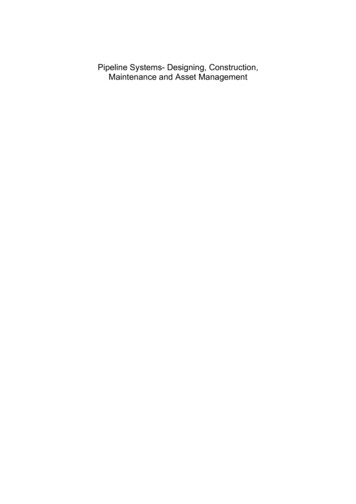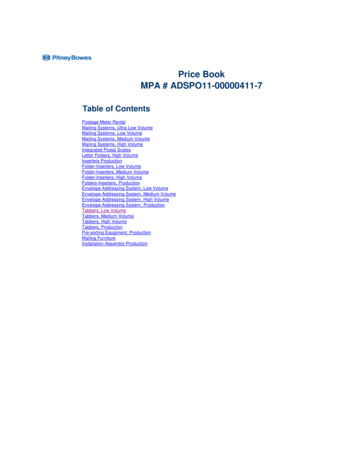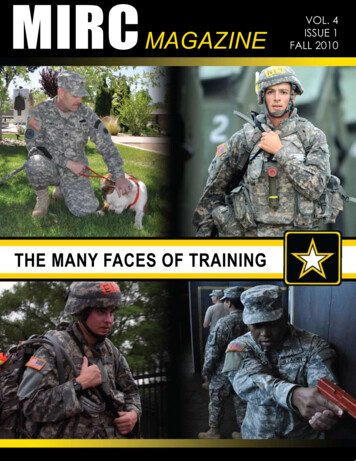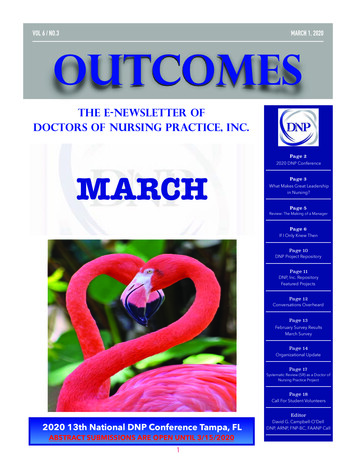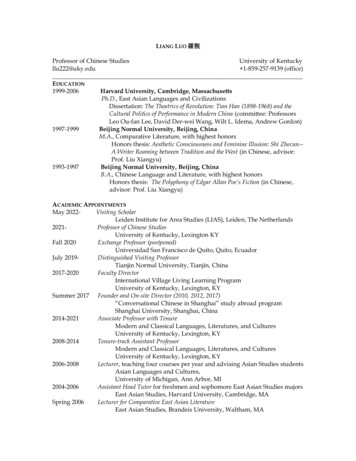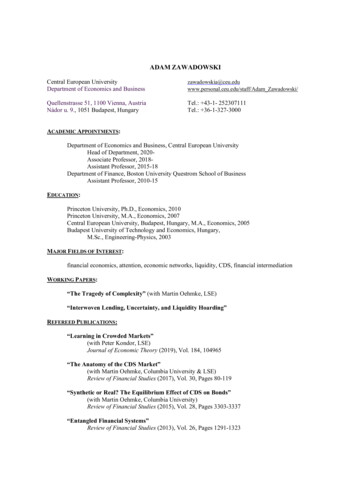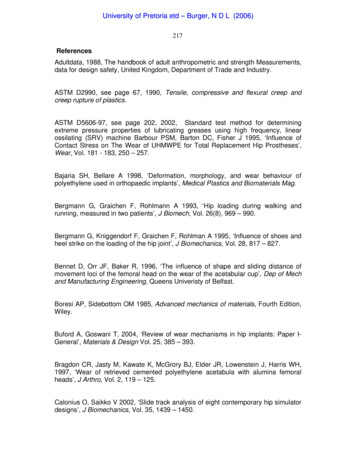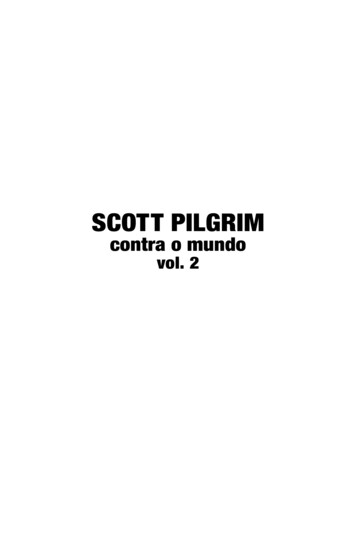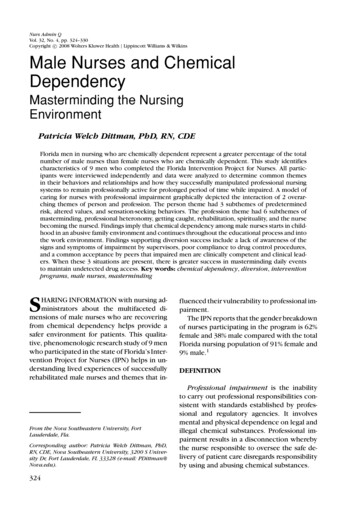
Transcription
Nurs Admin QVol. 32, No. 4, pp. 324–330c 2008 Wolters Kluwer Health Lippincott Williams & WilkinsCopyright Male Nurses and ChemicalDependencyMasterminding the NursingEnvironmentPatricia Welch Dittman, PhD, RN, CDEFlorida men in nursing who are chemically dependent represent a greater percentage of the totalnumber of male nurses than female nurses who are chemically dependent. This study identifiescharacteristics of 9 men who completed the Florida Intervention Project for Nurses. All participants were interviewed independently and data were analyzed to determine common themesin their behaviors and relationships and how they successfully manipulated professional nursingsystems to remain professionally active for prolonged period of time while impaired. A model ofcaring for nurses with professional impairment graphically depicted the interaction of 2 overarching themes of person and profession. The person theme had 3 subthemes of predeterminedrisk, altered values, and sensation-seeking behaviors. The profession theme had 6 subthemes ofmasterminding, professional heteronomy, getting caught, rehabilitation, spirituality, and the nursebecoming the nursed. Findings imply that chemical dependency among male nurses starts in childhood in an abusive family environment and continues throughout the educational process and intothe work environment. Findings supporting diversion success include a lack of awareness of thesigns and symptoms of impairment by supervisors, poor compliance to drug control procedures,and a common acceptance by peers that impaired men are clinically competent and clinical leaders. When these 3 situations are present, there is greater success in masterminding daily eventsto maintain undetected drug access. Key words: chemical dependency, diversion, interventionprograms, male nurses, mastermindingSHARING INFORMATION with nursing administrators about the multifaceted dimensions of male nurses who are recoveringfrom chemical dependency helps provide asafer environment for patients. This qualitative, phenomenologic research study of 9 menwho participated in the state of Florida’s Intervention Project for Nurses (IPN) helps in understanding lived experiences of successfullyrehabilitated male nurses and themes that in-From the Nova Southeastern University, FortLauderdale, Fla.Corresponding author: Patricia Welch Dittman, PhD,RN, CDE, Nova Southeastern University, 3200 S University Dr, Fort Lauderdale, FL 33328 (e-mail: PDittman@Nova.edu).324fluenced their vulnerability to professional impairment.The IPN reports that the gender breakdownof nurses participating in the program is 62%female and 38% male compared with the totalFlorida nursing population of 91% female and9% male.1DEFINITIONProfessional impairment is the inabilityto carry out professional responsibilities consistent with standards established by professional and regulatory agencies. It involvesmental and physical dependence on legal andillegal chemical substances. Professional impairment results in a disconnection wherebythe nurse responsible to oversee the safe delivery of patient care disregards responsibilityby using and abusing chemical substances.
Male Nurses and Chemical Dependency325LITERATURE REVIEWMETHODCurrent literature does not reveal studiesdiscussing male nurses and chemical dependency regarding prevalence, recidivism, or recovery. A lack of clarity exists on whethernurses are at risk for chemical dependencyat a greater rate than the general public,and studies quote different dependency rates.Kabb2 stated that nurses have a 50% higherrate of chemical dependency and 1 of 7 remain at risk. Research indicates that approximately 5% are alcoholic and 3% are dependenton drugs.3One study estimated that the prevalence ofsubstance abuse in nurses would be higherthan a comparison group of nonnurses, butconcluded that nurses did not have higher dependency rates.4 No reliable estimate existsfor the actual number of nurses who sufferfrom chemical dependency.5 Since 1984, theAmerican Nurses Association has estimatedthat 6% to 8% of the registered nurse population has a substance abuse problem.6Valid evidence of this phenomenon is thenumber of disciplinary actions taken by stateboards for nursing. The National Council ofState Boards of Nursing reported 68% of alldisciplinary actions stemmed from impairment activities.7Studies by the Institute of Medicine8 andthe Agency for Healthcare Research andQuality9 identify solutions in healthcare organization work environments that threatenpatient safety related to nursing care. Reportfindings and recommendations address the related issues of nursing leadership practices,workforce capability and design, and a cultureof organizational safety.Hermeneutic phenomenologic human science uses a dual-purpose method. It first explores or describes (phenomenologic) narrative material and second, it interprets(hermeneutic) conversational relationshipswith the interviewee about the meaningsof the experience.10 The interpreted component of this method provides a collaborative expression of the intimate relationshipbetween the study participant and the researcher.SAMPLECriteria for inclusion were male nurseswho successfully completed the rehabilitation portion of the Florida IPN. Nine men selfselected to participate. All participants verbalized success in academic environments whileactively using chemical substances. Facultyand fellow students were unaware of theirchemical substance use. Educational preparation ranged from an associate degree to a doctorate in education. Academically they weregrade A and B students during formal nursingeducation. All considered themselves perfectionists and intelligent and were recognizedby their leadership team as competent nurses.They experienced more frequent promotionsthan their female counterparts.None of the participants chose to selfreport their chemical dependency. All but onewere caught during a medication audit or aurine drug screen. All described their initial intervention with painful memories and activeemotions although all had been out of formalrehabilitation for 6 to 10 years.RESEARCH QUESTIONDATA COLLECTION ANDINTERPRETATIONThe question that directed the researchwas: What is the lived experience of malenurses who have successfully rehabilitatedfrom chemical dependency through the stateof Florida’s Intervention Project for Nurses?The interview process included unstructured and open-ended interview questions designed to elicit dialogue about the nurse’slived experience and personal life story,thereby gaining descriptions, phrases, and
326NURSING ADMINISTRATION QUARTERLY/OCTOBER–DECEMBER 2008Figure 1. Model of caring for nurses with professional impairment.themes. Data collection continued until theinformation contained reflected experiencesaturation by demonstrating response redundancy. The hermeneutic phenomenologicprocess allows the researcher to link thethemes to literature, thus guiding the interpretation. Common themes were grouped andthen meanings were added.Reflection on the data revealed 2 overarching themes of person and profession. Theperson theme and 3 subthemes are basedon self-relating and examine each individual’spersonal journey through addiction. The professional theme and 6 subthemes relate totheir professional interactions. The caring fornurses with professional impairment modelgraphically represents the interaction of these2 main themes along with 9 identified subthemes.ModelThe caring for nurses with professional impairment model graphically exhibits the 2 re-habilitation outcomes for chemically dependent male nurses. Two main themes of person and profession intertwine in an infinityfigure (Fig 1). Arrows represent potential actions and outcomes as nurses become mentally and physically dependent on chemicalsubstances. Spirituality is a common threadfor the rehabilitated nurses to transition fromperson to personhood.THE PERSON THEMEAll of the men interviewed felt that theiraddictive family history contributed to theirown eventual impairment and was a commonpredetermined risk. Personal chaotic environments starting in childhood were a mixture ofmental and physical abuse in the form of maltreatment, neglect, denial, and enabling behaviors providing an unstable lifestyle that followed them throughout their lives.Values guide decision making and lifechoices. As addiction progressed, personal
Male Nurses and Chemical Dependencyidentity was transformed by an alteration inself-view and self-worth. Common insight intothe world of maleness and nursing revealed asense of social exclusion. Men discussed common occurrences of exclusion from bonding experiences, social activities, and beingfully engaged with the team that enjoyed aperceived professional bond among femalenurses. Denial helped them move beyond thepain of addiction and disappointment in lifeand supported an altered value system. Repeatedly, study participants discussed usingdenial as a coping mechanism during their impairment. Denial and rationalization assistedwith a disconnection of the nurse-patient relationship. These men discussed that they valued the escape from reality that drugs provided. Access to medication was the mostimportant focus of their daily routine. Theirbehaviors of lying, hiding, denying, diverting, and manipulating affected their families,peers, patients, and the profession. All participants described their elaborate charade toconceal chemical dependency, not out of concern for others but because awareness wouldnegatively impact their drug access. Theemotional responses were reflective of thepersonal and professional devastation eachexperienced.Another common characteristic was thewillingness to take risks on a more grandiosescale. Sensation-seeking behaviors started inchildhood and remained intact for manyyears, undertaking risky actions regardless ofthe consequences. These sensation-seekingbehaviors were enabled during adolescencewhen teen-peer relationships escalate the progression down the wrong path. These menremember having no feelings related to themoral judgment of “should I do this?” Havingfriends who were active alcohol or drug usersenforced participation in this lifestyle.THE PROFESSION THEMEThe profession theme describes how chemically dependent men relate to the nursingprofession and survive in the workplace. This327section examined the description of theirprofessional journey through addiction. Sixsubthemes used to describe the effects thatchemically dependent nurses have on thenursing profession are masterminding, professional heteronomy, getting caught, rehabilitation, spirituality, and the nurse becomesthe nursed. Participants revealed that initiallythey used the profession for access, thrill, andself-esteem. They rebelled as impairment progressed and the profession called them to account for their behavior.Masterminding describes manipulation ofall connections to human and professional resources, including family, friends, professionalpeers, academic instructors, professional superiors, and the rehabilitation process. Eachdescribed having controlling behaviors overothers. Taking the hardest assignments andrising to the occasion were things they all didwell. Their sense of grandiosity was apparentas they assumed more tasks and then foundthat they could not manage the stress of responsibility.Professional heteronomy is the opposite ofautonomy whereby an autonomous person isone whose will is self-determined; a heteronymous person’s will is determined by something outside of the person, such as overwhelming desire.11 It reflects a disconnectionbetween the person and his or her professional duties. Connection to the professionand reasons why nursing was a career choicewere replaced by an overwhelming need fordrugs. Although there is a great desire to maintain control over others, the system, and theoverall situation, these nurses lacked controlof themselves.Getting caught is one of the biggest fearsfor the chemically dependent nurses andthey spend much effort to avoid it. Thesesnurses increasingly violated ethics. They discussed putting their needs before those oftheir patient. As this addiction progressed,their actions became less calculated and theywere more vulnerable to discovery. Most wereaware that increased work exposure providedincreased opportunity for surveillance. Thestaffing patterns of 3 days a week and 12-hour
328NURSING ADMINISTRATION QUARTERLY/OCTOBER–DECEMBER 2008shifts did not provide for sufficient observation, and therefore most felt that the 3 daysa week staffing pattern provides them withtime to indulge in drugs and still be ableto rebound emotionally and physically to return to work on schedule. The use of agencyand travel nurses also provides for poorsurveillance.Completing the rehabilitation program andreturning to practice was the biggest obstacle identified. Again being in an environmentwith access to drugs and thus the potential ofrecovery failure was a major stressor.Spirituality played a major role in impairment and recovery. All participants stated theneed to believe in a higher power, and 7 verbalized the need for this power to help themin their daily life. All 7 used the word “pray”asa dialogue with God. They needed to believethat God loved them no matter what they haddone in their past.The nurse becomes the nursed is anothercommon theme whereby the nursing profession reaches out to help the chemically dependent peer. From first recognizing this addiction and removing the nurse from practice tothe postrehabilitation phase, this is seen fromthe viewpoint of the impaired nurse as “savingmy life and my patients.” Although not alwayslooked upon as a caring intervention by eitherthe impaired nurse or the reporting nurse,calls for nursing, nursing response, and personhood served as substantive and structuralbasis for our conceptualization of “nursing ascaring.”12 Shared moments of authenticity between a nurse and another bring meaning tothe individual practitioner and the profession.Both grow in the symbiotic exchange of presence that allows choices to be made and livesto be changed. The impaired nurse is a person who deserves the rights of humanness toovercome substance abuse.FINDINGSTable 1 provides the findings that demonstrate that impaired male nurses do not fitthe stereotypical image of the chemically de-Table 1. Study findingsTendency for substance abuse among malenurses began in childhood.They were raised in emotionally andphysically abusive family environments.The nursing community lacks awareness ofdependency, impairment, andrehabilitation programs.Peers working with impaired male nurseslack awareness.Lack of compliance with policies andprocedures regarding drug controlsfacilitates access to drugs and diversion byimpaired nurses.Male nurses respond to stress byinternalizing it and could benefit frompoststress situation debriefings thatprovide an environment of professionalheteronomy.Impaired male nurses take more risks.Impaired male nurses were intelligent,productive, and thought to be clinicallycompetent by their colleagues.Nurse administrators were present duringthe initial intervention, but were absentwhen nurses returned to the practiceenvironment.pendent. The participants presented as intelligent, calm, and controlling individualswho were considered competent leaders inthe clinical setting and whose peers enjoyedworking with them. They served as clinical resources to others and volunteer for complexand difficult clinical assignments. Voluntarilyworking overtime hours was also common.The length of practice while impaired rangedfrom 6 to 22 years. All had excellent evaluations from their supervisors and appeared toadvance in the organization despite undiscovered chemical dependency issues. They personally felt that they were good nurses untilthe chemical dependency got out of control.The ability to compartmentalize issues andbe able to successfully complete a difficultfield of study while impaired served to reinforce that they could maintain drug-using behaviors while practicing nursing.
Male Nurses and Chemical DependencyMen in the study stated that they deal withstress differently on the basis of societal rules.When they have a difficult patient or a negative outcome, they tend to keep their emotions internal. They seek outlets for theseemotions, and alcohol or drugs is one way tocope. Most felt that nursing is a lonely profession for them because they are not part of apeer group and there are few mechanisms fora team approach to critical evaluation of negative outcomes. They felt that if nursing hada postcritical incidence debriefing process, itwould help relieve stress.When chemically dependent nurses arecaught, their peers often appear surprised.Most men in the study felt that their nursingpeers were not aware of their impairment andeven contributed to it by having substandardpractices for wasting of narcotics. These menfelt that the profession first cared about themas people after the initial intervention to confront their impairment issues.Participants verbalized how difficult it wasto return to practice. Regardless the areaof practice, being around narcotics was thebiggest threat to successful rehabilitation.Knowing that future drug use meant the lossof their nursing license, they constantly fearedthe temptation. They also felt that the nurseadministrator was very involved in the initialintervention and their removal from practicebut was absent from any involvement in theirreturn to practice and provided little support.Believing in something greater than themselves and feeling their spirituality saved their329life gave them an avenue to give back to others. One of the ways they felt they gave backto nursing was by participation in this study.Many verbalized that their motivation for participation was to be heard and to help othersby telling their stories.The male nurses who participated in thestudy all reviewed the model of caring fornurses with professional impairment and approved its representation of their addictionstruggle. The model graphically portrayedtheir personal journey dealing with addiction.All 9 are successful in life, and 2 chose toleave nursing. The 7 who remain in practicehave been clean of their addiction for 2 to 8years. The 2 who chose to leave nursing feelthat the pull of narcotic addiction is so strongthey can never return to practice.CONCLUSIONProfessional impairment is an important issue for nurse leaders. Awareness and knowledge sharing about impairment with nursingmanagement teams are important. It is thechemically dependent male nurse who willskillfully mastermind the workplace environment to meet his or her addictive needs.Nurse executives need to be present at theintervention as well as the return to practice. Educating frontline nurse managers andstaff nurses about chemical dependency, behavior identification, treatment, and the rehabilitation process provides for a safer return topractice for the rehabilitated nurse.REFERENCES1. State of Florida. Intervention Project for Nurses annual report. Available at: www.myflorida.com. Accessed January 16, 2008.2. Kabb G. Chemical dependency: helping your staff. JNurs Adm. 1984;14(2):18–22.3. Buxton M, Jessup M. Nurses and the art of healing.Focus Alcohol Drug Issues. 1985;5(3):5–21.4. Trinkoff A, Eaton W, Anthony JC. The prevalence ofsubstance abuse among registered nurses. Nurs Res.1991;41(3):172–175.5. Sullivan E, Bissell L, Williams E. Chemical Dependency in Nursing. Menlo Park, Calif: AddisonWesley; 1988.6. American Nurses Association. Addictions and Psychological Dysfunctions in Nursing: The Profession’s Response to the Problem. Kansas City, Mo:American Nurses Association; 1984.7. National Council of State Boards of Nursing. Modelguidelines: a non-disciplinary alternative programfor chemically dependent nurses. Available tm. Accessed February 22, 2006.8. Institute of Medicine. Keeping patients safe: transforming the work environment of nurses. Availableat: http://books.nap.edu/openbook.php? AccessedJanuary 12, 2008.
330NURSING ADMINISTRATION QUARTERLY/OCTOBER–DECEMBER 20089. Agency for Healthcare Research and Quality. Workand workplace design to prevent and mitigate errors.Available at: http://www.nap.edu/openbook.php?Accessed January 12, 2008.10. van Manen M. Researching the Lived Experience:Human Science for a Action Sensitive Pedagogy.London, Ontario, Canada: The Althouse Press; 2003.11. Henman LM. Ethics: A Pluralistic Approach toMoral Theory. 3rd ed. San Diego, Calif: ThomsonWadsworth; 2003.12. Boykin A, Schoenhofer SO. Nursing As Caring: AModel for Transforming Practice. Boston: Jones &Bartlett; 2001.
of nurses participating in the program is 62% female and 38% male compared with the total Florida nursing population of 91% female and 9% male.1 DEFINITION . tion portion of the Florida IPN. Nine men self-selected to participate. All participants verbal-ized success in academic environments while actively using chemical substances. Faculty
